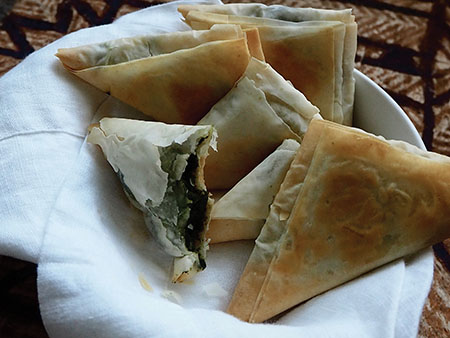
Local Food: The Gift of Kalo, with a Recipe for Taro Greens and Feta Phyllo Triangles
 By Brittany P. Anderson
By Brittany P. Anderson
Something stirs inside of me with each writing assignment, yet diving deep into kalo (taro) farming on Hawai‘i Island for this issue felt a little more profound. Waipi‘o Valley in its truest untamed form is a place of spiritual connection where you can commune with nature as wild horses saunter by and clouds crawl down the valley walls.
I was given my first taro by a man we met from Craigslist, Wilson, who was selling purple sweet potatoes by the 50-pound sack. “Do you have taro at your place?” he asked as we stood in his driveway. He had tried to sell us a small goat just before the question. I had no sooner finished my reply, “No, we don’t,” when he handed me the tops of four upland taro plants.
“Just put them in mulch, and you’ll have plenty,” he said while we tossed the taro into the back of our truck. Farming upland taro still requires water which is luckily quite consistent in Hilo. I planted the taro in my garden, with plenty of mulch, and fertilized with compost whenever I remembered.
When we purchased our farm in Honomū almost two years ago, we found two different old kalo patches on the property. On a hill under the mango trees, upland taro grows at breakneck speed while along the stream a wetland variety flourishes.
Several months after we purchased our farm, a man was driving past as I locked the gate. “I think I know you,” he said with a squint of his eyes, “I think you bought potatoes from me.” Indeed we had—it was Wilson. “My family used to farm this spot,” he said pointing behind me.

On a later visit to Waipio, as I stood in the middle of the valley, with walls of green surrounding us and blue sky reflecting off the flooded taro patch, my past and present collided. Taro can be propagated by cutting the green tops off just below the young roots. The result, the huli, are then stuck back in the ground to form the edible corm again.
I went home to compare my two upland taro patches—the one I planted in my garden and the one that was there when we bought our farm. Could it be? It turns out they are both the same, having a hint of red splashed under the leaf and a thin red line along the edge. We were always connected to the land; we just hadn’t realized it yet.
All parts of taro must be cooked thoroughly due to the presence of oxalic acid when raw. Cooking taro dissolves the oxalic acid. If any part of the taro is undercooked, it may cause itching, needlelike sensation, and extreme discomfort. When cooked, the leaves can be substituted for spinach, collard greens, and even Swiss chard.
Friends invited us over for dinner; however, I was running late and forgot to pick something up for pupu (appetizers). So, I went into the garden, plucked taro leaves, and whipped up a batch of a new spin on the Greek spanakopita called Taro Greens and Feta Phyllo Triangles.
Taro Greens and Feta Phyllo Triangles

1 stick (1/2 cup) unsalted butter
6 cups roughly chopped taro leaves
8 oz local feta
½ tsp local nutmeg
1 package phyllo dough
Pinch of salt and pepper
Put taro leaves in a medium-sized pot on medium heat with just enough water to cover the base. Stir until wilted and tender, about 10 minutes. Do not let leaves brown or burn, you want a soft paste. Remove from heat and cool. Preheat oven to 375°F.
Working in batches, squeeze handfuls of taro leaves to remove as much liquid as possible. Transfer to a bowl and stir in feta, nutmeg, salt, and pepper. Melt butter.
Take 1 phyllo sheet, place on dry work surface lengthwise and brush evenly with butter. Place another phyllo sheet on top, brush with butter. Cut horizontally into 3 strips. Place a tablespoon of filling near the upper corner of each piece, then fold over to make a triangle. Continue folding, like a flag/paper football, to maintain the triangle.
Place triangle closure side down on baking sheet and brush the top with melted butter. Continue until you run out of taro mixture. Bake on the middle rack of your oven until golden—approximately 20 minutes. Let cool slightly before diving in.
Enjoy!
Photos by Brittany P. Anderson


